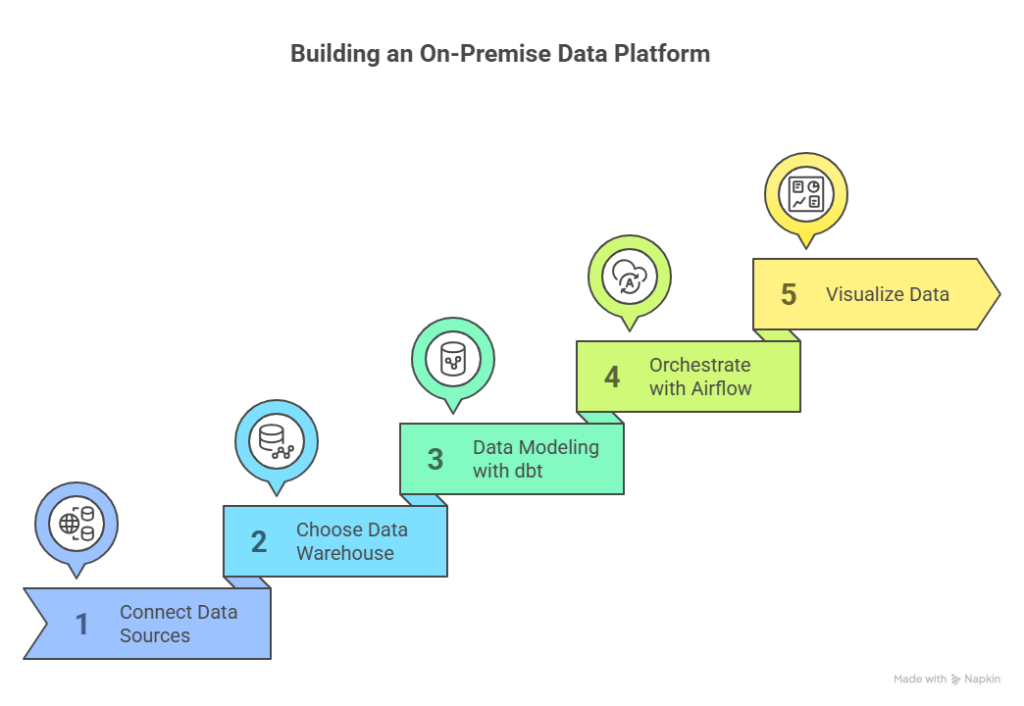In today’s competitive retail and e-commerce world, building an effective on-premise data warehouse can make or break how data is turned into business insights. If you’re looking to move beyond spreadsheets or reduce long-term cloud costs, an on-premise data warehouse offers greater control, flexibility, and cost-efficiency — when implemented right.
This guide walks through the core components and best practices to help you build and maintain an efficient on-premise system.

Section 1: Connecting to Your Data Sources (From OLTP Systems & APIs)
Your first step in designing an on-premise data warehouse is connecting to operational systems (OLTP — Online Transaction Processing) and external APIs such as marketing platforms.
From Relational Databases (e.g., MySQL, PostgreSQL, SQL Server):
- Host: IP address or server name.
- Port: Common ports — 3306 (MySQL), 5432 (PostgreSQL), 1433 (SQL Server).
- Username & Password: Ensure the user has read access.
- Database/Schema: Target schema for extraction.
- Driver: Use JDBC/ODBC or native database drivers.
From Marketing APIs (e.g., Facebook Ads):
- Access Token: For API authentication.
- App ID / Secret: To identify your application.
- Business Manager ID: Tied to your Facebook business account.
- Ad Account ID: From which to pull data
Section 2: Choosing Your On-Premise Data Warehouse & Cost Optimization
Recommended On-Premise Data Warehouse: ClickHouse
- Fast columnar storage, excellent for aggregation-heavy queries, and open-source
- Hardware sizing guide: ClickHouse recommendations
Environment Setup: Split your environment
- Development: For data modeling and pipeline testing
- Production: Clean, validated data for dashboards
Cost Optimization:
- Run development environments during working hours
- Use smaller instances where appropriate
Replica Setup:
- Purpose: Backups, disaster recovery, scaling reads
- Types: Asynchronous or real-time synchronization
- Recommendation: One replica for BI/reporting and one for backup in high-query environments (10+ users every hour with filters by product, region, and channel)
Handling Semi-Structured or NoSQL Data:
- Compress data before storing
- Use MongoDB for JSON-style data
- Use HDFS for large unstructured datasets
- Consider cloud storage if data volume is low
Section 3: Data Modeling with dbt
dbt (Data Build Tool) transforms raw warehouse data into clean, analytics-ready models:
- SQL-based and user-friendly for analysts
- Git-native workflows enable version control
- Supports CI/CD for testing and deployment
- Automatically generates documentation and lineage
Section 4: Orchestration with Apache Airflow
Automate on-premise data warehouse pipelines using Apache Airflow.
Why Airflow?:
- Widely adopted with strong community support
- Supports Python, SQL, Bash, and other scripting languages
- Compatible with cloud and on-premise environments
- Allows creation of custom operators
Example Use Case: Schedule ETL jobs at 2AM, apply transformations with dbt by 3AM, and refresh dashboards by 6AM.
Section 5: Data Visualization Tools
Selecting the right visualization tools is critical to maximizing the value of your on-premise data warehouse. These tools turn raw and modeled data into insights that are easy to interpret and share.
Open-Source Options: Metabase, Apache Superset
- Pros: Lightweight and license-free
- Cons: Requires technical setup and ongoing maintenance
Enterprise / Subscription Tools: Power BI, Tableau, Looker
- Pros: Rich user interface, advanced analytics, support availability
- Cons: Licensing costs (e.g., Power BI Pro starts at $10/user/month)
Final Thoughts: Start Simple, Scale Smart
Building an on-premise data warehouse is about more than just selecting the right tools — it’s about establishing a scalable foundation tailored to your business’s size, data volume, and analytical needs.
For retail and e-commerce businesses, success depends on aligning performance, security, and usability while ensuring data is actually usable for decision-making.
Begin with:
- One reliable data source
- One clean warehouse
- One actionable dashboard
Then scale as needed.
